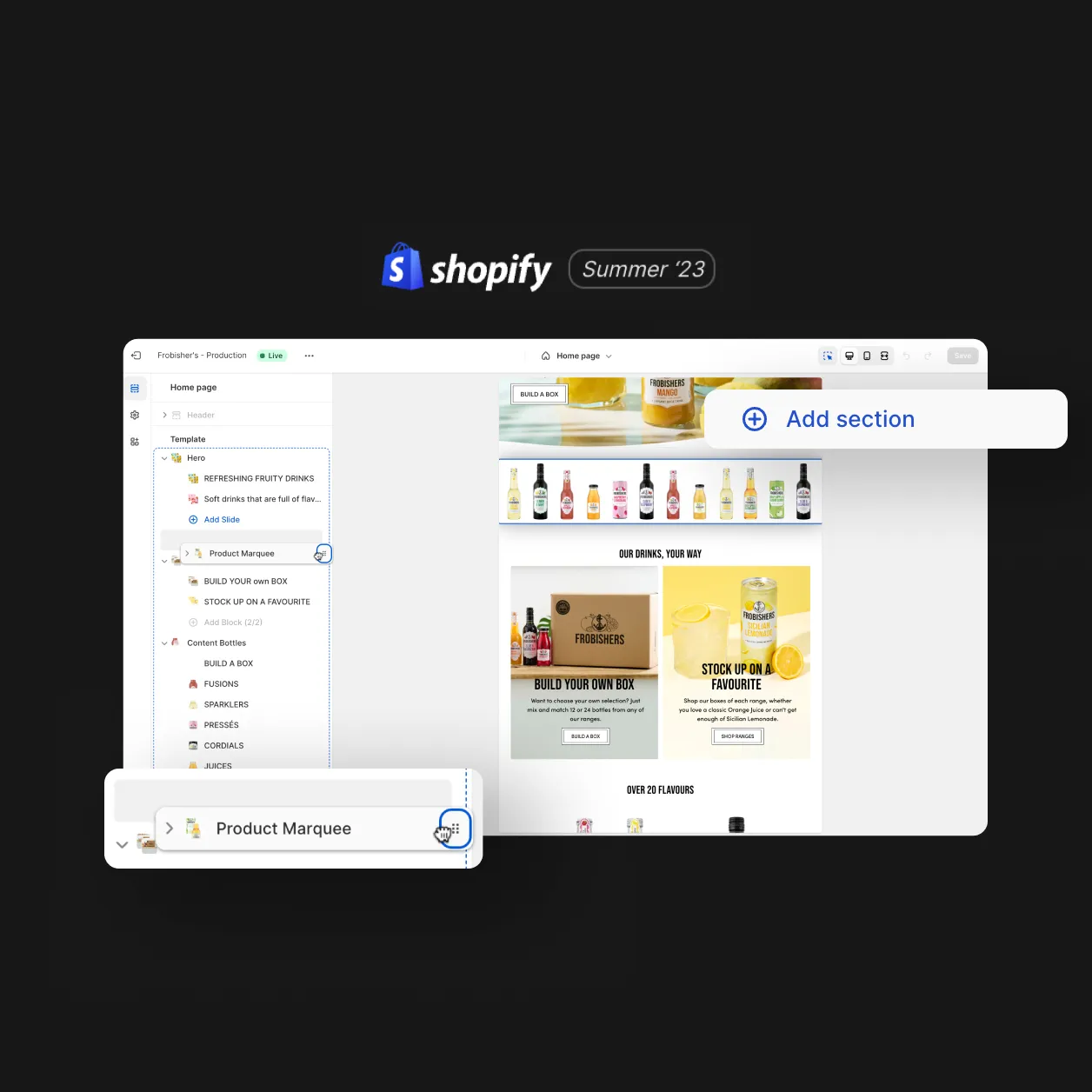
As your online store keeps on growing, have you reached the point where your ecommerce platform is no longer delivering performance? Are there growth opportunities you’re missing out on because of its limitations? We compare Shopify to its big enterprise offering, Shopify Plus, to outline the key features of each and when you need to consider an upgrade.
Introduction to Shopify and Shopify Plus
Let’s start with the fact that Shopify is the third biggest ecommerce platform in the world and is behind more than 800,000 online stores and is a powerhouse platform used by retailers of all sizes to successfully sell online.
So, before we dive straight into the differences between Shopify and Shopify Plus, it’s important to understand what exactly Shopify offers.
Shopify pricing, plans and transaction fees.
There are three main Shopify plans rangeing from $29 to £299 per month and each offer:
- An eCommerce website and blog
- Unlimited products
- 24/7 support
- Abandoned cart recovery
- Discount codes
- Fraud analysis
So how do Shopify justify the different monthly subscription fees?
At just $29/month, Basic Shopify comes with:
- Up to 2 staff accounts
- Online credit card rates of 2.9% plus 30 cents per transaction
- 2% additional fee for using third-party payment providers (instead of Shopify Payments)
In comparison, a Shopify plan costs $79/month and comes with:
- Up to 5 staff accounts
- Online credit card rates of 2.6% plus 30 cents per transaction
- 1% additional fee for using third-party payment providers
- The option to use gift cards, access to professional reports and USPS priority shipping pricing
Finally, their Advanced Shopify plan costs $299/month and includes:
- Up to 15 staff accounts
- Online credit card rates of 2.4% plus a 30-cent transaction fee
- 5% additional fee for using third-party payment provider
- All features from the standard Shopify plan, along with advanced reporting and third-party calculated shipping rates
As a rule of thumb, the number of staff accounts you need and the credit card processing fees will be the main drivers of the plan you’ll choose.
It is worth keeping in mind that you can upgrade or downgrade your plan at any time, which gives you the flexibility to choose the best fit for your current needs and you can benefit from a 10% discount if you commit to an annual plan and even a 20% discount if you pay up front for a biennial plan.
Shopify also offers Shopify Lite, a plan that doesn’t give you a website or a blog, but lets you sell through Messenger, add products to your existing website, and accept credit card payments for only $9 per month.
What is the difference between Shopify vs Shopify Plus?
All three Shopify plans clearly offer lots of opportunities for retailers to grow and market their online stores, without the need for coding or website development skills.
But if you’ve read this far, the question you likely want to know is at what point would you move to Shopify Plus?
While their dashboards give the impression that Shopify and Shopify plus work in a similar way, that is where the similarities end. In fact, as Shopify Plus is an enterprise eCommerce platform made to power some of the world’s fastest-growing brands, including the likes of Kylie Cosmetics and Gymshark, they offer a higher level of customisation than Shopify.
More specifically, Shopify Plus benefits include:
- Multiple languages and currencies: You can create a multi-country experience with fully personalised content, products, languages, and prices to the local market.
- High volume of sales: Shopify Plus is designed to handle as many as 10,000 transactions per minute without crashing or failed purchases—great for opportunities like Black Friday sales.
- Dedicated, personalized support: You’ll get dedicated, Shopify Plus-trained account managers, so you’ll be supported in your launches, day-to-day operations, and have priority support.
- Unlimited staff accounts: Everyone involved in your growth can have their own account in your store. So, if you’re requiring more than 15 accounts, it may be time to consider migrating to Shopify Plus.
- Fully customised checkout: You can brand and optimise your checkout experience, make tweaks for conversion optimisation and provide more flexibility.
- Custom discounts and flash sales: Promote products on sale across multiple channels, create pre-set discounts, return pricing to normal when campaign ends, and more—all done automatically with Launchpad.
Ultimately, Shopify Plus gives you full control over every step of the purchase experience, while taking the stress out of maintaining that success in the long run.
What does Shopify Plus cost?
Shopify Plus: Pricing structure and transaction fees.
If your store’s monthly revenue is below $800,000, Shopify Plus will cost you $2,000 per month.
As soon as your revenue hits $800,000, your fee will turn into a revenue-based model. More specifically, you will pay 0.25% of your store’s monthly revenue, capped at $40,000 per month.
Here’s what you can expect to pay based on your Shopify Plus store’s sales volume:
- $0 to $800,000 – you’ll pay $2,000
- $1,000,000 – you’ll pay $2,500
- $5,000,000 – you’ll pay $12,500
- $12,000,000 – you’ll pay $30,000
- $16,000,000 and more – you’ll pay $40,000
You’ll pay 1.6% plus 35 cents per transaction, as well as an additional 0.15% per transaction if you choose to use a third-party payment provider instead of Shopify Payments.
The downside of the Shopify Plus pricing structure is that, unlike with standard Shopify plans, you never pay a fixed fee. It fluctuates based on your store’s revenue for the given month.
Shopify vs Shopify Plus: Choosing the right option.
Still on the fence between Shopify’s standard plans and leaping into Shopify Plus? In this section, we’re laying out the main reasons you’ll benefit from going with Shopify Plus. The more of these statements that are true for your online store, the more advantages you’ll get with Shopify Plus.
Your team has more than 15 people.
Shopify’s standard plans limit your team accounts to 15 seats, so if you have a bigger team than that, there’s a chance you’re missing out on opportunities to scale.
For example, if only a limited part of your team can access your Shopify dashboard at the same time, it probably means you’re:
- Not fulfilling orders as fast as you could
- Not making the most of all sales channels and marketplaces
- Taking longer to execute launch plans
- Not marketing your products on all the platforms you could be
In other words, you’re growing, but you’re leaving money on the table by not scaling as early as you could. Analyse how your team works to understand if more staff accounts would accelerate your growth.
Your store makes £1-2 million or more in annual revenue.
This isn’t a hard and fast rule, and every store’s needs are different.
However, once you’re over this threshold, there’s a chance you’ll benefit from unique features and additional, one-on-one support.
This way, you can focus on the right things in your store instead of worrying about technical features or figuring out a way around design limitations.
From automating your launches to learning from the Shopify Plus Academy and much more, Shopify Plus will help you bring more revenue to your store without bringing more stress.
You’ve identified opportunities for CRO
Are there customer touchpoints and specific parts of your ecommerce experience where your customers abandon their cart? Have you thought of a way to increase average order value or get your customers to purchase more often?
If your current setup limits your chances to improve these areas, Shopify Plus will give you the control you need to optimise and customise these touchpoints.
Some examples of this are:
- Altering your homepage to match previous purchases and interests of a customer
- Fully customising shipping methods based on customer tags or cart contents
- Bundling products and offering unique promotions to specific customers or groups
You’re selling into multiple geographies (or you’re planning to expand).
Selling internationally is complex – not just because of languages and currencies – but also because it takes time to adapt to different buying habits and behaviours.
With Shopify Plus, you can easily create these store versions tailored to countries other than yours. You won’t spend extra time figuring out the technicalities behind these clone stores—Shopify Plus does that for you.
Your new version of the store is already tailored to the geography you’re targeting thanks to world’s leading payment gateways and international carrier services. They’re also mobile-ready, and easy to update for seasonal trends and local shopping habits.
It’s also worth noting that if you’re expanding your website into new territories, it can pay to internationalise your SEO efforts to improve your chances of reaching new global audiences.
Both Shopify and Shopify Plus come with benefits that make running an ecommerce business painless. You also get the same access to new features such as Shopify Subscription API.
Design
Inspiring behaviour change through visual experiences. Our digital design services ensure instant clarity and visuals that cut-through in a cluttered market.




